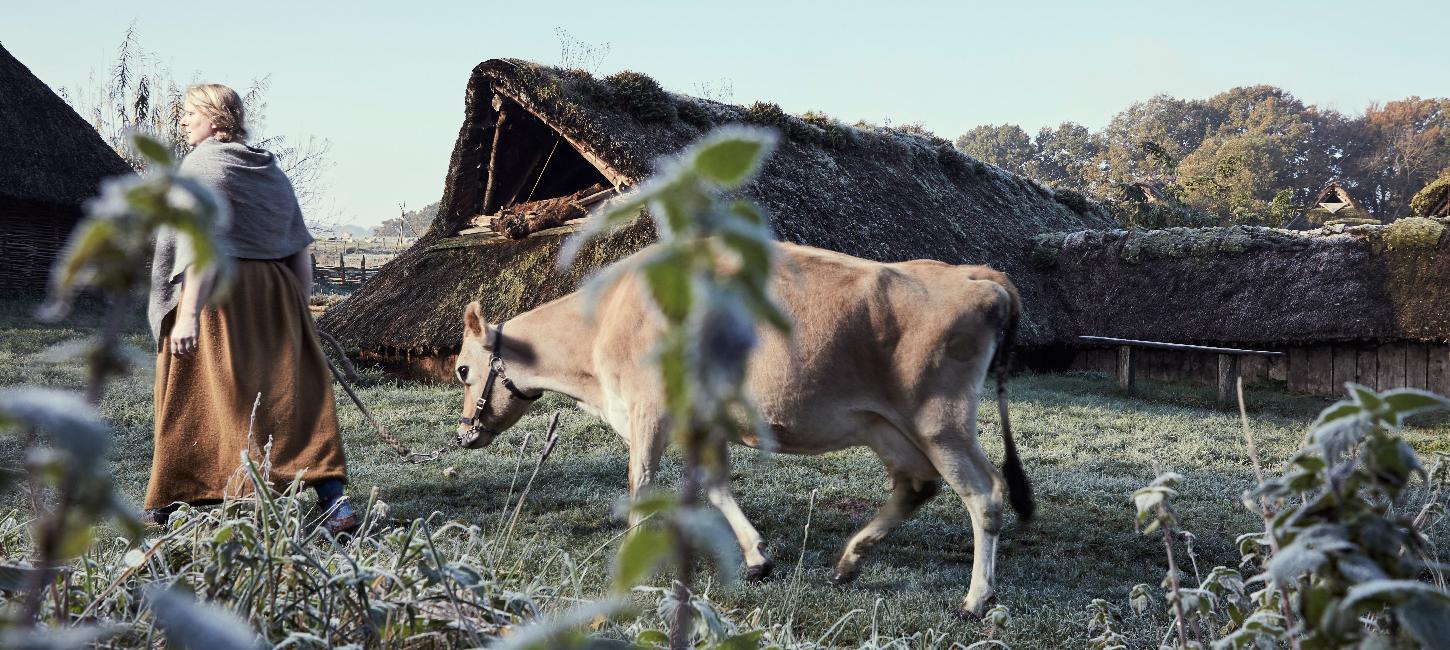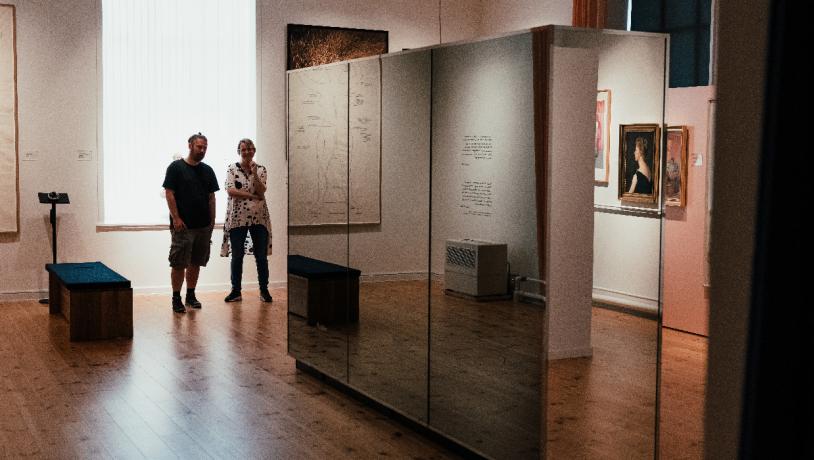
Vejle Museums - History and Culture
See all of the interesting things in art, history, archaeology and fun interactive experiences. Vejle Museerne offers rich cultural and historical exhibitions. Admission is free, with both permanent and special exhibitions.
Look for Rembrandt in the brushstrokes. Experience the power of the bog and one of the world’s best-preserved bog bodies. Explore wind power version 1.0 from the 1850s, and all sorts of other exciting art, history and archaeology and fun interactive experiences.
Vejle’s large museum organisation, Vejle Museums, consists of 10 museum experiences in Vejle Municipality, and all have free admission for children and adults.

Photo:Vejlemuseerne

Photo:Vejlemuseerne

Photo:Vejlemuseerne
Vejle Art Museum
At Vejle Art Museum, you can experience art in all its forms - you will find graphic prints, Golden Age art and sculptures in the collection, which began in the 1890s. Here, private citizens got involved in setting up an art museum that would be open to all. The museum opened its doors in 1901 and is now housed in a beautiful setting designed by Kim Utzon Architects. As a visitor to Vejle Art Museum, you can get up close and personal with works by artists such as Rembrandt, Robert Jacobsen and Asger Jorn. You can also experience unique special exhibitions inspired by current themes and debates.
Arrange your visit exactly as you like - experience the art on your own or book a guided tour. Don’t forget to take a break for reflection in the museum’s café, and take the Art Museum’s Sculpture Guide under your arm as you go. Then you can extend your visit by hunting for the many sculptures placed around Vejle.
The Art Museum has good accessibility for wheelchair users and people with walking difficulties.
The Cultural Museum
The Cultural Museum is located in Vejle’s old spinning mills in the West Town, and here you will find several exhibitions that tell about Vejle’s history from ancient times to today. Take a trip back to the Iron Age, where the original exhibited objects tell the story. Experience the power of the bog by getting up close and personal with one of the world’s best-preserved bog bodies - a woman long mistaken for Queen Gunhild. Learn about industrialisation and life as a worker in Vejle, when life was turned upside down by the cotton industry and the iron foundry in Vejle. It started with long hours, dangerous working conditions and low pay, but it soon got better. In 1891, the workers got Sundays off. And in 1920, the Social Democratic government led by Stauning introduced an 8-hour working day, and a life of freedom, associations and celebration began because nobody decided what you did when the factory whistle blew, and you got the day off.
The Cultural Museum
The Ravning Bridge
in Vejle
The Ravning Bridge - Denmark’s longest bridge for 1,000 years
The Ravning Bridge is just one of several historic constructions from Harald Bluetooth’s time, and they all testify to Harald Bluetooth’s high ambitions and the enormous resources he devoted to achieving them. The Ravning Bridge is unique. It was the longest bridge in Danish history for almost 1,000 years, and it was only surpassed when the bridge we now call the old Little Belt Bridge was built in 1935. The Ravning Bridge measured 760 metres and was 5 metres wide. Today, a section of the bridge has been reconstructed so you can see how advanced the Vikings were at building with wood. What Harald used the bridge for is uncertain. It has probably only been in use for a few years, as there is no evidence that it was ever repaired.
If you are on a trip through Vejle Ådal, you should take time for a stop in Ravning Enge. You can visit the Ravning Bridge as a stop on the Bindeballe Trail.
The stretch between Vejle city and the Ravning Bridge is wheelchair accessible. However, the entry to the reconstructed bridge is not wheelchair accessible.
Bindeballe Station
Perhaps you have been there and experienced Bindeballe Merchant’s House. Look over to the other side of the road. Bindeballe Station is located here. Bindeballe served as a station on the old Vandel railway. The station building from 1897 now functions as a museum, where you can go in and see the reconstructed ticket office and waiting room. Outside you will find an old DBS carriage from 1928, a campsite with facilities and the old tracks. Today the popular Bindeballe hiking and cycling trail passes by the station.
The Blackfriar Kiln
One of the more unknown experiences in Vejle is the Blackfriar Kiln. Historians believe that the so-called Blackfriar monks took over a wooden church in the Middle Ages but chose to build a brick monastery church in Vejle. They then constructed a brick kiln to fire large medieval bricks for the building. They were part of a tremendous technological leap from the wooden structures of the Vikings to more durable stone buildings. The technique of making large medieval bricks came to Denmark around 1160. It’s incredible to think that it was only 200 years after Harald’s men were busy building oak royal and ring fortresses. Today you can see the remains of a medieval brick kiln on Jagtvej in Vejle.
Robert Jacobsen-Jean Clareboudt Landscape Sculpture
At Tørskind Gravel Pit, you will find one of Denmark’s few landscape sculptures. The sculpture consists of nine sub-sculptures, which together are to be experienced as one work of art. The large, monumental sculptures are built with natural materials such as concrete, iron, granite and wood. They put us, little people, in to play in nature and start a dialogue between heaven and earth. Depending on the time of day and the year, the sculptures can be experienced quite differently. They are located along an extensive, hilly path system in Tørskind Gravel Pit, so you can experience the sun’s path from the eastern sunrise to the western sunset as you walk through the exhibition.
Combine your trip to the landscape sculpture with a walk along Vejle Å in the beautiful river valley.
The Iron Age in Vingsted
The Iron Age Village in Vingsted is one of the largest in Denmark. It consists of houses, fields, workshops, sacrificial sites and much more, which together create a settlement as it looked in the Iron Age. You are always welcome to take a walk in the Iron Age Village but remember that the houses are only open during events and activities. Plan your visit in advance if you want to see it all. In summer, you can join Aud or Ravnhild on one of the regular tours or go to one of the annual Iron Age markets. You can also book a tour to suit your programme and learn more about the past.
Visit the Iron Age Village in Vingsted and experience what life was like for people 2,000 years ago. As a guest in the Iron Age, you can participate in everyday life at a completely different pace from what we know today. The flour is ground by hand, the clothes are dyed, and the animals must be cared for. Some days, rituals are performed to gain the gods’ support during difficult times. On other days there are markets or festivals. A visit to the Iron Age Village in Vingsted is for the history enthusiast, the artisan and the nature lover, or just those who want a day at a leisurely pace.
The Iron Age Village in Vingsted is unsuitable for wheelchair users and people with walking difficulties.
Vejle Windmill - Danish wind power version 1.1
The first windmill was built in Denmark in the 13th century. It was a post mill. The mill stood on a post, and when the wind shifted, you had to turn the whole mill around upwind. In the early 1800s, a new mill came to the country, the Dutch mill. Here, only the cap of the mill turns. It could be built stronger and was easier to handle. Vejle Windmill is a tower mill, a variant of the Dutch windmill, where the tower is made of stone.
The windmill is Vejle’s #1 landmark. It is located in the hills in the southern part of Vejle, and from here, Vejle Windmill towers up and can be seen in large parts of the city. The fine old mill dates from 1890, but there has been a mill on the site since 1846. Look inside the mill and see the fixtures dating from the 1930s. Climb the stairs in the windmill and get a great view of Vejle city, Grejsdalen, the fjord and the river valley from the top of the windmill. If you are interested in art, you can enjoy the Vejle Art Association’s art exhibition inside the mill.
Randbøldal Museum
At Randbøldal Museum, you can learn how paper and clothes were produced in the old days. On selected days, there are paper and weaving workshops. Outside you can try your hand at water experiments. It was here, in Jutland’s first industrial village, that a paper mill was established in 1732. Later, a clothing factory was added. Vejle Å was the basis for production because of the hydropower in the river.
The Egtved Girl’s Grave
The Egtved Girl is one of Europe’s finest Bronze Age finds, which happened when farm owner Peter Platz came across a heavily cut oak trunk in 1921. Find out the story of the Egtved Girl’s Grave. Here you can see the small exhibition about the 16-year-old girl who was found over 100 years ago in an oak coffin in a small mound in a field. See a copy of the dress and the oak chest. Please note that the original find is resting in The National Museum of Denmark.








